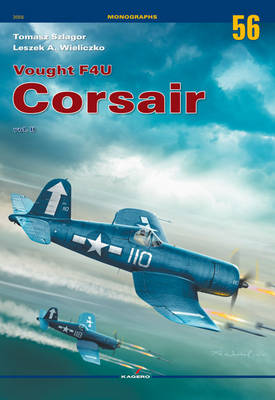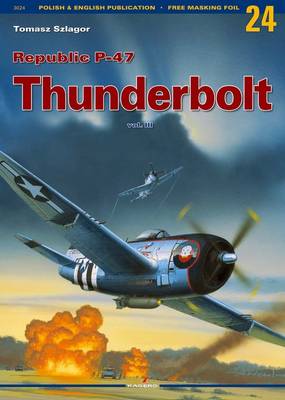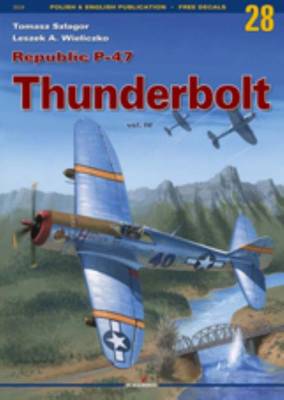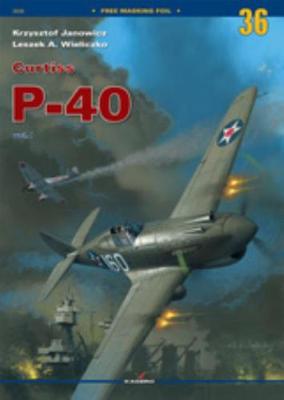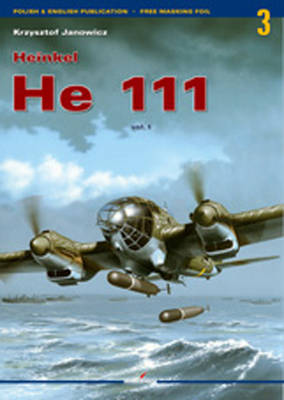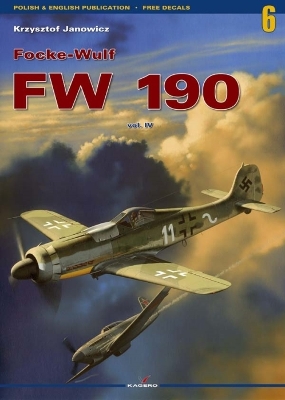Monographs
6 total works
The second volume carries on the story of the F4U Corsair by examining its development and operational service in later stages of the World War Two.
By early 1944 the Corsair well proved its worth in combat. Finally qualified for carrier operations, it began to challenge the Hellcat’s status of the US Navy’s primary fighter aircraft. The F4U-1D, capable of carrying nearly a ton of bombs and eight rocket missiles, excelled both in aerial combat and ground attacks. It’s fighter-bomber capabilities were put to good use during the little-known campaigns in the Marshalls, Marianas and Palau Islands, as well as in the Philippines, which are related here in unparalleled detail. Much attention is dedicated to the initial deployment of the Corsair (both night and day fighters) aboard US Navy carriers, spanning the period between February 1944 and March 1945, which culminated in the first raids against Japan.
Meanwhile, Vought and Goodyear engineers continued to improve and refine the Corsair. New, more powerful engines enabled them to develop two more versions before the war’s end– the ultimate Corsair (Vought F4U-4) and the Super Corsair (Goodyear F2G-1/2). Their story is related in the opening chapter. A separate chapter is devoted to camouflage and markings of British and New Zealand’s Corsairs, with a brief resume of the aircraft’s service in the two air forces. The book is further supplemented by numerous data in tabular form, color profiles of five representative aircraft and 1/48 scale drawings of various versions.
•112 pages
•112 black and white photos
•18 pages A4 sheet of scale drawings
•5 painting schemes
•Format (sizes): (275x205 mm)
•Soft cover binding
By early 1944 the Corsair well proved its worth in combat. Finally qualified for carrier operations, it began to challenge the Hellcat’s status of the US Navy’s primary fighter aircraft. The F4U-1D, capable of carrying nearly a ton of bombs and eight rocket missiles, excelled both in aerial combat and ground attacks. It’s fighter-bomber capabilities were put to good use during the little-known campaigns in the Marshalls, Marianas and Palau Islands, as well as in the Philippines, which are related here in unparalleled detail. Much attention is dedicated to the initial deployment of the Corsair (both night and day fighters) aboard US Navy carriers, spanning the period between February 1944 and March 1945, which culminated in the first raids against Japan.
Meanwhile, Vought and Goodyear engineers continued to improve and refine the Corsair. New, more powerful engines enabled them to develop two more versions before the war’s end– the ultimate Corsair (Vought F4U-4) and the Super Corsair (Goodyear F2G-1/2). Their story is related in the opening chapter. A separate chapter is devoted to camouflage and markings of British and New Zealand’s Corsairs, with a brief resume of the aircraft’s service in the two air forces. The book is further supplemented by numerous data in tabular form, color profiles of five representative aircraft and 1/48 scale drawings of various versions.
•112 pages
•112 black and white photos
•18 pages A4 sheet of scale drawings
•5 painting schemes
•Format (sizes): (275x205 mm)
•Soft cover binding
Republic P-47 Thunderbolt Vol. III
by Tomasz Szlagor and Leszek A. Wieliczko
Published 5 January 2010
The third part of a monograph on P-47 Thunderbolt discusses its combat use as fighter-bomber in Western Europe starting from D-Day till the end of 1944.
The air battles over Normandy and the actions during the race to the Rhine, the invasion on southern France and Operation`Market-Garden’ together with the Battle of the Bulge are thoroughly described in the separate chapters.
The author uncovers the fates of particular fighter units as well as individual pilots who fought in them.
112 pages, 100 photographs, 20 sheets of technical drawings in 1:24, 1:48 and 1:72 scale with specification of external changes in production-run versions of the aircraft, 11 colour charts with 16 examples of camouflage schemes.
About the Series
Monographs focuses on an individual type of aircraft. Each monograph contains descriptions of the aircraft’s origin, its variants and combat history. Each volume includes several hundred archive photographs, technical scale drawings and colour profile artwork. Each book also has free extras for modellers, with decals and masking foil.
The air battles over Normandy and the actions during the race to the Rhine, the invasion on southern France and Operation`Market-Garden’ together with the Battle of the Bulge are thoroughly described in the separate chapters.
The author uncovers the fates of particular fighter units as well as individual pilots who fought in them.
112 pages, 100 photographs, 20 sheets of technical drawings in 1:24, 1:48 and 1:72 scale with specification of external changes in production-run versions of the aircraft, 11 colour charts with 16 examples of camouflage schemes.
About the Series
Monographs focuses on an individual type of aircraft. Each monograph contains descriptions of the aircraft’s origin, its variants and combat history. Each volume includes several hundred archive photographs, technical scale drawings and colour profile artwork. Each book also has free extras for modellers, with decals and masking foil.
The last, fourth part of a monograph on P-47 Thunderbolt discusses its combat use as fighter-bomber in Western Europe during the last few months of WW2. The air battles over Southern Europe in 1944-1945 are also thoroughly described.
Another chapter is devoted to Thunderbolt’s service in the RAF, the Free French AF, the Brazilian AF, the Mexican AF and the Chinese AF together with other foreign operators. The author uncovers the fates of particular fighter units as well as individual pilots who fought in them. The book includes technical data and lists of units operating the P-47.
Free 1:48 and 1:72 decals for 3 schemes:
P-47D-30-RA (s/n 44-33721) of Escuadron Aereo de Pelea 201, July 1945.
P-47D-30-RE of the Columbian Air Force.
P-47D-40-RA (s/n 45-49506) of Grupo de Aviacion 11, Chile.
About the Series
Monographs focuses on an individual type of aircraft. Each monograph contains descriptions of the aircraft’s origin, its variants and combat history. Each volume includes several hundred archive photographs, technical scale drawings and colour profile artwork. Each book also has free extras for modellers, with decals and masking foil.
Another chapter is devoted to Thunderbolt’s service in the RAF, the Free French AF, the Brazilian AF, the Mexican AF and the Chinese AF together with other foreign operators. The author uncovers the fates of particular fighter units as well as individual pilots who fought in them. The book includes technical data and lists of units operating the P-47.
Free 1:48 and 1:72 decals for 3 schemes:
P-47D-30-RA (s/n 44-33721) of Escuadron Aereo de Pelea 201, July 1945.
P-47D-30-RE of the Columbian Air Force.
P-47D-40-RA (s/n 45-49506) of Grupo de Aviacion 11, Chile.
About the Series
Monographs focuses on an individual type of aircraft. Each monograph contains descriptions of the aircraft’s origin, its variants and combat history. Each volume includes several hundred archive photographs, technical scale drawings and colour profile artwork. Each book also has free extras for modellers, with decals and masking foil.
The first part of a monograph on Curtiss P-40 constitutes a thorough insight into its origins and development of the versions B, C, D and E. Each version is specified and described with coverage of changes made in its variants and sub-variants, including the special modifications for the foreign recipients.
A separate chapter is devoted to the combat use of the early versions of P-40 in the RAF and the RAAF service in North Africa and the Middle East, where P-40, called Tomahawk or Kittyhawk, proved to be the most effective Allied fighter until the arrival of Spitfire Mk Vs. The book also features short accounts of the Soviet use of P-40 and dramatic action of U.S. P-40s in the defence of Pearl Harbour.
Complete with 92 pages, 102 photographs, 24 sheets of technical drawings in 1:48 and 1:72 scale with specification of external changes in production-run versions of the aircraft, 9 colour charts with 11 examples of camouflage schemes.
About the Series
Monographs focuses on an individual type of aircraft. Each monograph contains descriptions of the aircraft’s origin, its variants and combat history. Each volume includes several hundred archive photographs, technical scale drawings and colour profile artwork. Each book also has free extras for modellers, with decals and masking foil.
A separate chapter is devoted to the combat use of the early versions of P-40 in the RAF and the RAAF service in North Africa and the Middle East, where P-40, called Tomahawk or Kittyhawk, proved to be the most effective Allied fighter until the arrival of Spitfire Mk Vs. The book also features short accounts of the Soviet use of P-40 and dramatic action of U.S. P-40s in the defence of Pearl Harbour.
Complete with 92 pages, 102 photographs, 24 sheets of technical drawings in 1:48 and 1:72 scale with specification of external changes in production-run versions of the aircraft, 9 colour charts with 11 examples of camouflage schemes.
About the Series
Monographs focuses on an individual type of aircraft. Each monograph contains descriptions of the aircraft’s origin, its variants and combat history. Each volume includes several hundred archive photographs, technical scale drawings and colour profile artwork. Each book also has free extras for modellers, with decals and masking foil.
The first part of a monograph on the German WW2 bomber, Heinkel He 111 describes the development history of its all versions with coverage of changes made in their variants, sub-variants and field modifications. Originally designed as a bomber plane, He 111 was used as a torpedo and reconnaissance aircraft as well as - after the unique modification - for towing huge Me 321 gliders. The book features a detailed description of the aircraft’s structure and technical data and a chapter about camouflage and markings.
Complete with 112 pages, 99 photographs, 18 sheets of technical drawings in 1:48 and 1:72 scale with specification of external changes on production-run versions of the aircraft and 5 colour charts with 8 examples of camouflage schemes.
Free 1:48 and 1:72 decals for 5 schemes:
Heinkel He 111 P-2,`1G+EK’ of 2./KG 27 “Boelcke”, Werneuchen (Germany), September 1939.
Heinkel He 111 H-6,`1H+FK’ of 2./KG 26, Grosseto (Italy), December 1942.
Heinkel He 111 H-6,`1H+AH’ of 1./KG 26, Barduffos (Norway), Summer 1942.
Heinkel He 111 H-16,`5J+ER’ of 7./KG 4, Białystok (Poland), Spring 1944.
Heinkel He 111 H-20,`5J+GH’ of 1./KG 4, Dresden (Germany), April 1945.
About the Series
Monographs is a series focusing on an individual type of aircraft. Each monograph contains descriptions of the aircraft’s origins, its variants and combat history. Each volume includes several hundred archive photographs, technical scale drawings and colour profile artworks, with free extras for modellers, including decals and masking foil.
Complete with 112 pages, 99 photographs, 18 sheets of technical drawings in 1:48 and 1:72 scale with specification of external changes on production-run versions of the aircraft and 5 colour charts with 8 examples of camouflage schemes.
Free 1:48 and 1:72 decals for 5 schemes:
Heinkel He 111 P-2,`1G+EK’ of 2./KG 27 “Boelcke”, Werneuchen (Germany), September 1939.
Heinkel He 111 H-6,`1H+FK’ of 2./KG 26, Grosseto (Italy), December 1942.
Heinkel He 111 H-6,`1H+AH’ of 1./KG 26, Barduffos (Norway), Summer 1942.
Heinkel He 111 H-16,`5J+ER’ of 7./KG 4, Białystok (Poland), Spring 1944.
Heinkel He 111 H-20,`5J+GH’ of 1./KG 4, Dresden (Germany), April 1945.
About the Series
Monographs is a series focusing on an individual type of aircraft. Each monograph contains descriptions of the aircraft’s origins, its variants and combat history. Each volume includes several hundred archive photographs, technical scale drawings and colour profile artworks, with free extras for modellers, including decals and masking foil.
The monograph on the Focke-Wulf Fw 190 D and Ta 152 discusses their origins and development, technical details of subsequent variants and sub-variants, and camouflage and markings. The book also describes the operational history of both aircraft during the last months of WW2 and compares them to their RAF and USAAF opponents. It contains the production list of Fw 190 D with serial numbers; technical data and lists of the most successful pilots of Fw 190 D and pilots who scored while flying Ta 152s.
English & Polish text, 112 pages, 115 photos, 22 sheets of 1:48 scale drawings, which include specification of external changes on production-run versions of the aircraft, 11 pages of colour charts with 24 examples of camouflage schemes.
English & Polish text, 112 pages, 115 photos, 22 sheets of 1:48 scale drawings, which include specification of external changes on production-run versions of the aircraft, 11 pages of colour charts with 24 examples of camouflage schemes.
